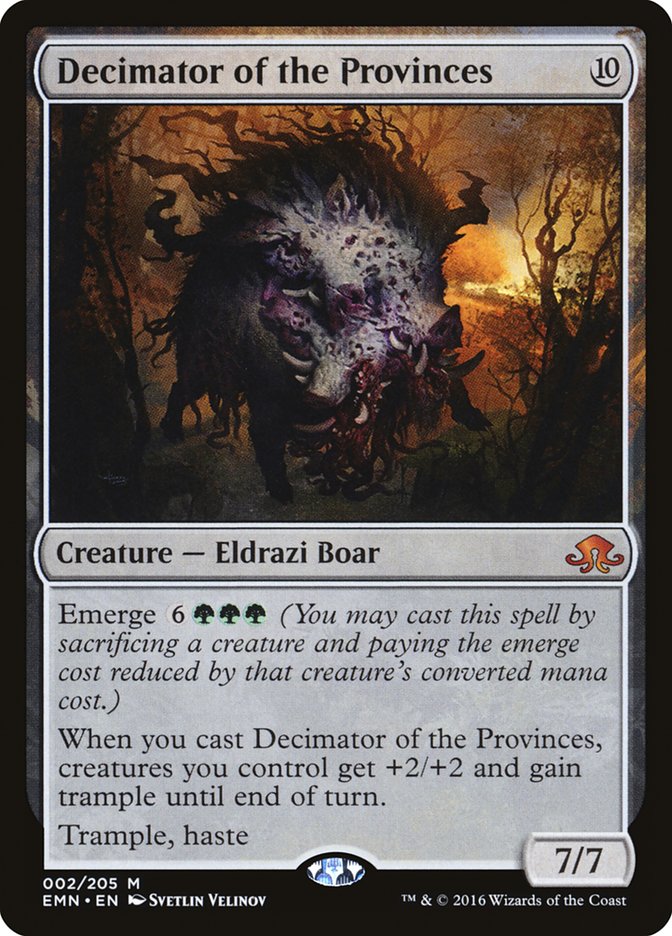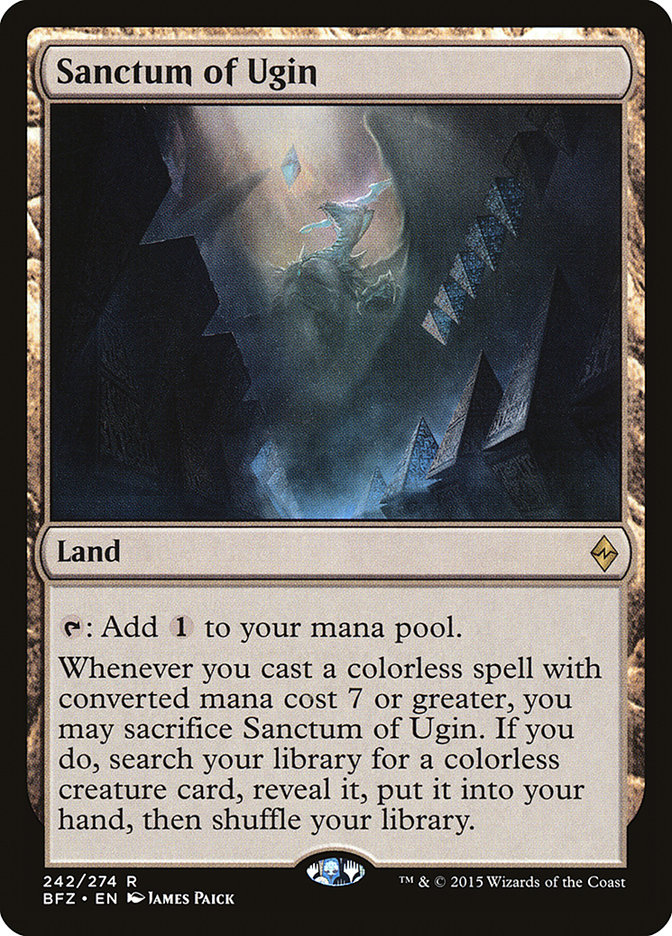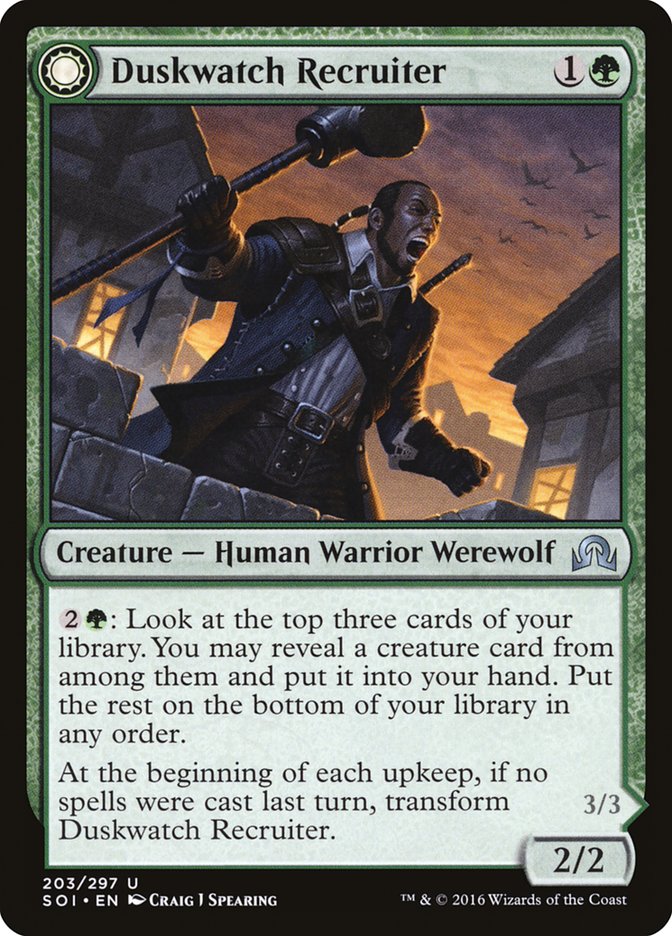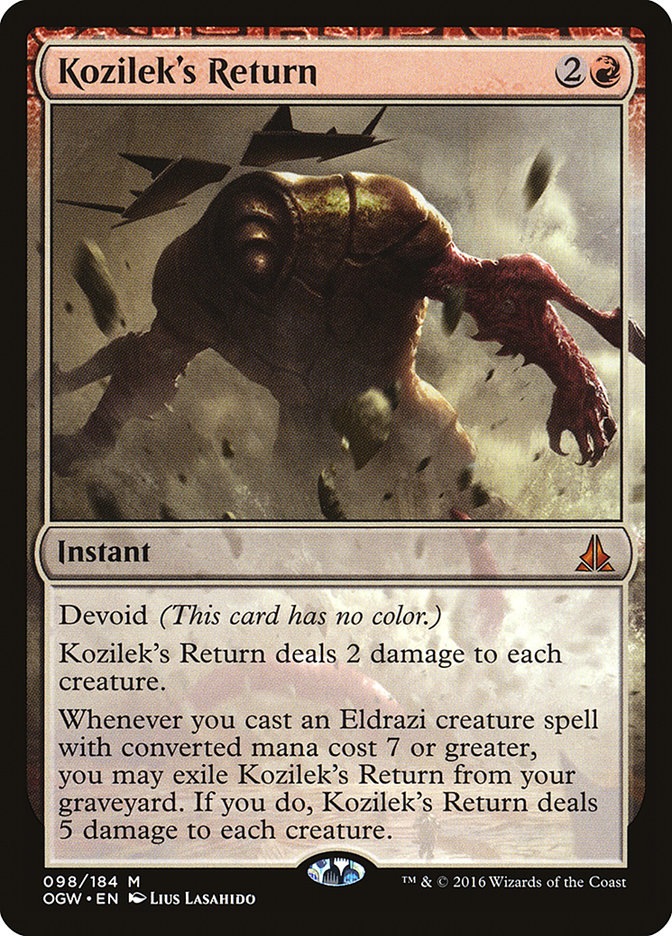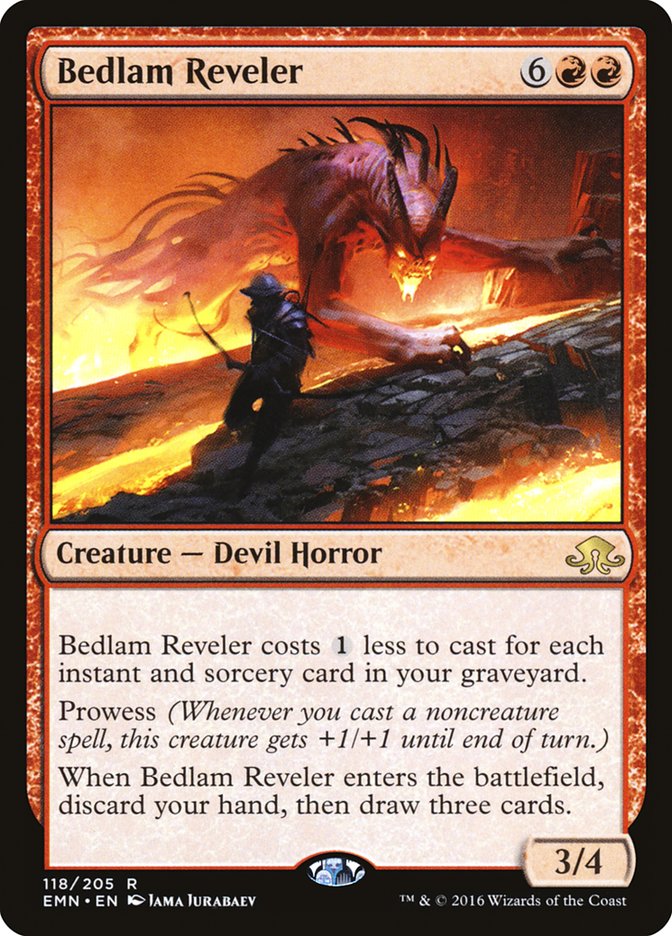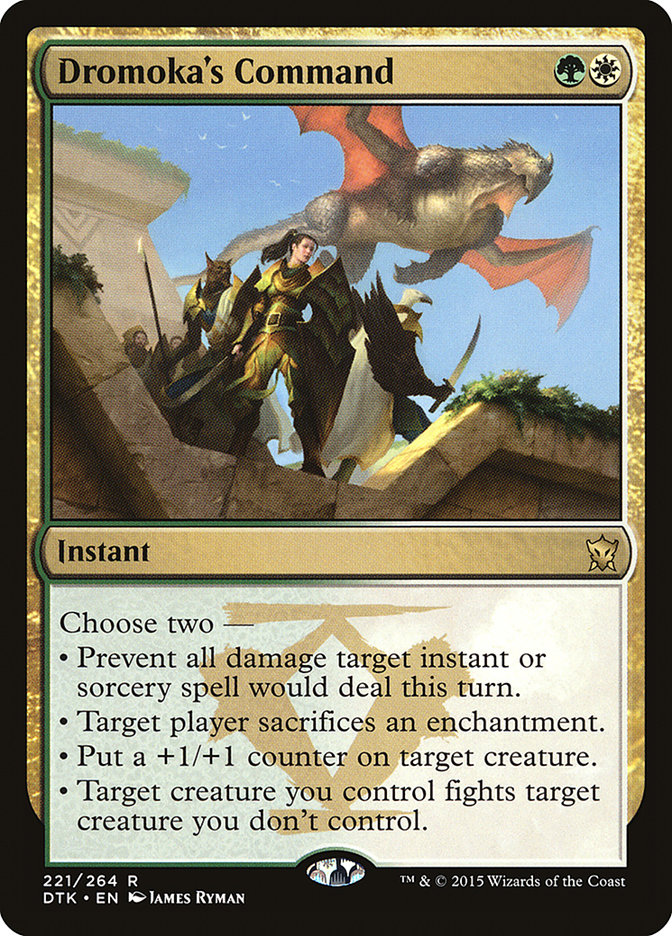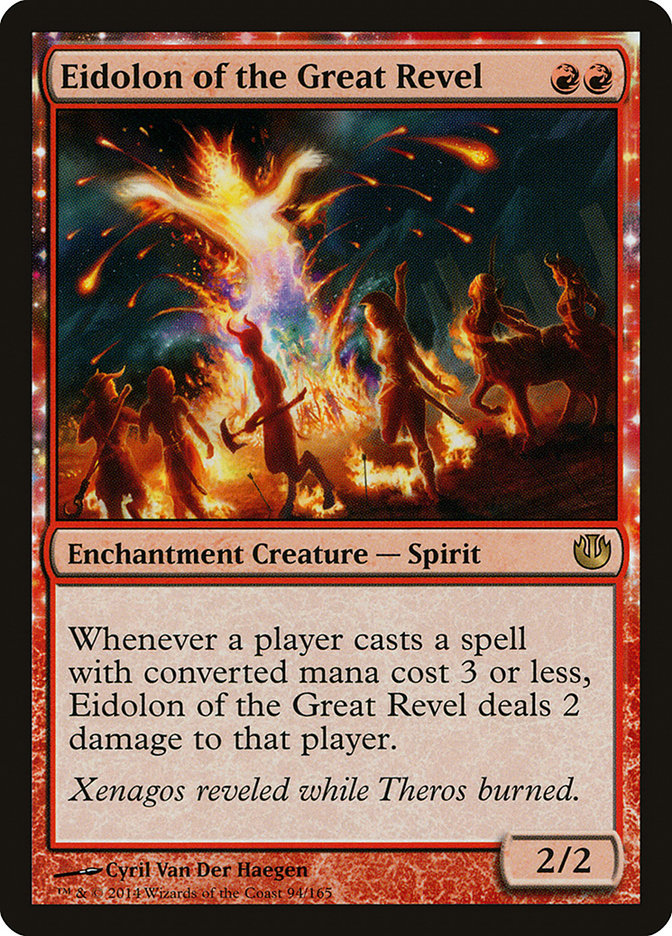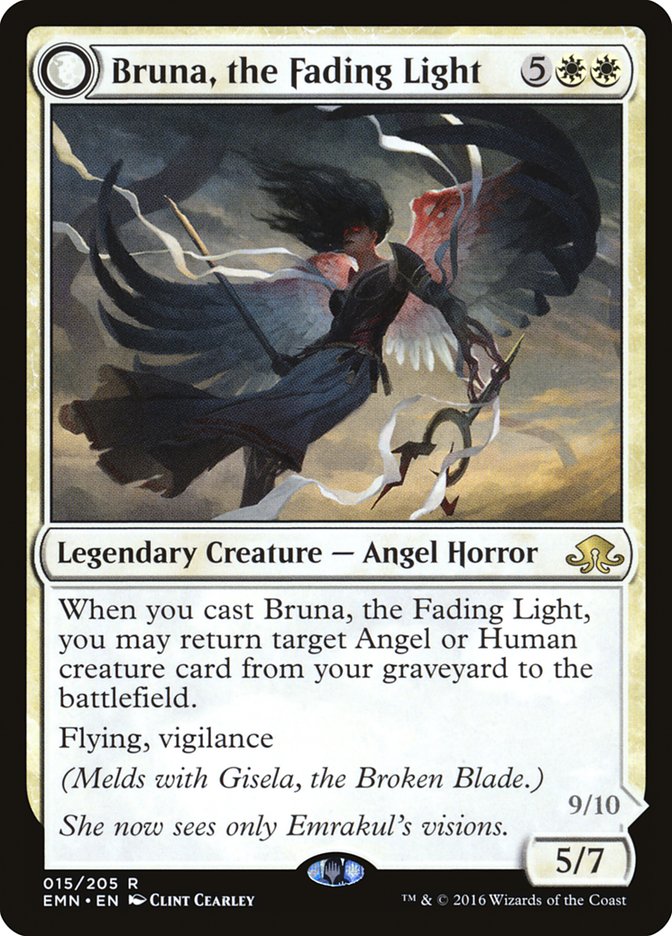Playing events on the The SCG Tour® the weekend that a new Magic set comes out is hard. Every three months or so, it always feels like more testing is necessary and everybody else is a little bit more prepared. Sometimes it’s a bit easier when a set is low-power (looking at you, Born of the Gods) and doesn’t have an enormous impact on Standard; other times a set is full of archetype-defining powerhouses that can completely warp the format.
Eldritch Moon has an outlandishly high number of powerful cards, making it near-impossible to actually put the time in and test every possible archetype. Sometimes, even with testing, many decks tend to fall just short of being a Tier 1 deck, missing some sort of puzzle piece or some role-player that it needs to take it to the next level.
Decimator of the Provinces may be the most frustrated I’ve been with a new Magic card in a long time. This card is so powerful and feels like it would naturally slot in to a handful of existing archetypes relatively easy, but everything feels like it is missing something.
Creatures (29)
- 3 Nantuko Husk
- 4 Elvish Visionary
- 4 Catacomb Sifter
- 4 Blisterpod
- 4 Zulaport Cutthroat
- 4 Duskwatch Recruiter
- 4 Loam Dryad
- 2 Decimator of the Provinces
Lands (23)
Spells (8)

I recently featured this list in my debut article here on StarCityGames.com and was quite sincere when I said that I planned to start my playtesting for #SCGCOL with Nantuko Husk & Co. (pun intended). From playing the deck previously, I only took a couple of games to get my sea legs so-to-speak, but I found the deck being picked apart by Dromoka’s Command either destroying Cryptolith Rite or key Zulaport Cutthroats and Liliana, Heretical Healers for me to be comfortable taking the deck to a tournament.
Part of this deck’s gameplan involves making a very fast Ormendahl, Profane Prince and using it to put the opponent on a one- or two-turn clock. With Spirits looking to become a very popular deck, this isn’t nearly as good. Most of their creatures fly, and Ormendahl isn’t nearly as powerful when it just causes them to sacrifice a creature each turn until they find a Reflector Mage to deal with the transformed land.
The next step with Decimator of the Provinces actually came from recent friend and SCG Tour® regular Aaron Sorrells:
Creatures (34)
- 4 Leaf Gilder
- 4 Shaman of Forgotten Ways
- 1 Ulamog, the Ceaseless Hunger
- 3 World Breaker
- 2 Scion Summoner
- 4 Hedron Crawler
- 4 Deathcap Cultivator
- 4 Duskwatch Recruiter
- 4 Loam Dryad
- 4 Decimator of the Provinces
Lands (22)
Spells (4)

This deck is the just about as Decimator of the Provinces-focused as a deck can possibly be. The whole plan of the deck is just to play ramp creatures until a near-endless stream of colorless fatties (provided by Sanctum of Ugin and Duskwatch Recruiter) puts the game away.
One angle of attack that this deck has that other Ramp decks tend to lack is this deck’s ability to convert early ramp spells (read: mana creatures) into damage via Decimator of Provinces. A bane of many Ramp decks is that their first threat or two being answered can result in a stream of very weak topdecks (Explosive Vegetation for lands number twelve and thirteen, anyone?) but this archetype can attack and block with the extra “lands” that it draws.
The biggest drawback when playing this particular deck is how soft it was to Kozilek’s Return and Languish. Recent Magic sets have had very few cards that interact with players’ lands and traditional Ramp strategies use this to their advantage. A more common Josh Dickerson-styled ramp deck uses this to its advantage and makes an unspoken treaty to the effect of “I won’t disrupt you for the first few turns of the game, but you can’t disrupt me either.” It’s much easier to break this paradigm when the “extra lands” being put onto the battlefield have meager amounts of toughness and are as fragile as creatures tend to be.
After investing this much time in Decimator of the Provinces, it was hard to move on to trying other cards in the set, but at this point I’m confident that, while Decimator of the Provinces is something with power levels that deserve a large amount of Standard play, now may not be the time.
Bedlam Reveler may be the biggest
Eldritch Moon seems to be a set in which Wizards of the Coast is really trying to see where the line is between balanced cost-reduction mechanics and unbalanced cost-reduction mechanics. Between this and emerge it is very likely that this is something very unfair to be exploited here.
Sam Black wrote an article last week with a handful of different decklists abusing cards from the new set and one in particular stuck out to me:
Creatures (9)
Lands (26)
Spells (25)

There is a lot going on here. The goal is to fill the graveyard as quickly as possible in order to make Splendid Reclamation and Bedlam Reveler as broken as they can be. World Breaker is even a recursive threat that plays well with the discard subtheme in Tormenting Voice and Bedlam Reveler.
This deck was quite powerful but ended up getting shelved due to the deck’s problems with Dromoka’s Command and Spell Queller. Both cards are manageable on their own but are problematic when backed up by a reasonable amount of pressure.
This may be my pick for deck that I’d most like to see a more streamlined and tuned version come out of the woodworks. There’s a lot of powerful stuff going on here and it’s hard to imagine there isn’t something more.
Another approach to looking at Bedlam Reveler is viewing it as more of a curve topper than an engine card. Ross Merriam and Dalton Ozmun were the de facto champions of a Stormchaser Mage-centered aggressive deck upon the release of Oath of the Gatewatch:
Creatures (16)
Lands (21)
Spells (23)
- 1 Dispel
- 4 Titan's Strength
- 4 Treasure Cruise
- 2 Temur Battle Rage
- 2 Roast
- 4 Fiery Impulse
- 2 Expedite
- 4 Slip Through Space
Sideboard

When Khans of Tarkir block rotated with the release of Shadows over Innistrad, I had the privilege of working with Dalton, and despite his infatuation with Stormchaser Mage, he couldn’t make the deck work without the power to gas back up that Treasure Cruise provided.
Bedlam Reveler can pull double-duty as a threat and refueling option:
Creatures (16)
Lands (22)
Spells (22)

The goal of this particular archetype is to nickel and dime the opponent for a few points of damage here and there before ultimately finishing the opponent off with a single combat step that deals eight to ten points of damage.
Setting up these kinds of combat steps and sneaking damage in with creatures that don’t necessarily have evasion (Abbot of Keral Keep and Bedlam Reveler, for instance) can take a few cards and leave the pilot a few cards short of actually closing out a game. Bedlam Reveler being able to push for the last few points of damage and generating those last few cards to punch through the damage is just what the doctor ordered in many cases.
Another application of Bedlam Reveler is using it as a finisher in a more spell-focused Modern Burn:
Creatures (8)
Lands (21)
Spells (31)

This take on Burn aims to minimize the impact of opposing removal spells and have a better game against the various flavors of lifegain in Modern. Monastery Swiftspear, Goblin Guide, and Grim Lavamancer are generally some of the most valuable spells in a Burn deck…if left unchecked. Modern has reached a point in which it is so streamlined that decks have adapted to the hasted threats in a way that makes them generally worth less than a Lava Spike in net points of damage to the opponent. This makes a less explosive but more consistent take on the deck a significantly more attractive option.
Eidolon of the Great Revel does a great impression of a spell in that it deals damage to the opponent without attacking and forces the opponent to do more than just ignore it. Eidolon of the Great Revel tends to serve as a sort of Remand in this archetype in that it almost immediately eats a portion of an opponent’s turn with a positive exchange rate for its owner.
Unlike a majority of aggressive strategies, this take on Burn is generally favored when the game goes a bit longer. Finding the pocket to kill the opponent is naturally important, but every draw step that both players gain (read: every turn of the game that comes with a prolonged game) results in another asset that will eventually result in the opponent’s death.
The largest concern with this particular list is getting clogged on Bedlam Revelers and Searing Blazes. Burn tends to flounder a bit against the unfair strategies in Modern and this deck exacerbates that issue. For this variant of Burn to be any better than current iterations of the deck, a very good sideboard plan would be required to combat the various Griselbrand, Ad Nauseam, and Wurmcoil Engine decks of the format.
Despite her sister, Gisela, the Broken Blade, getting all of the attention this spoiler season, I think that Bruna, the Fading Light may end up being a much bigger tournament player.
Regular travel-mate and StarCityGames.com Player of the Year Top 32 point holder Robert Wright had used her to fantastic effect in a U/W Control shell:
Creatures (1)
Planeswalkers (5)
Lands (26)
Spells (28)

Against the slower and grindier decks that have trouble presenting a clock, Robert sideboards into the Angel package. In playtesting, Bruna would oftentimes be returning a Linvala, the Preserver to the battlefield for a major swing. Seven mana for a 5/5 with flying, a 5/7 with flying, a 3/3 with flying, and five life is back breaking. Most of the games in which Gisela found her way onto the battlefield, she would end up getting dealt with or outclassed by a larger threat rather quickly. Her inclusion is merited as her sister’s date-night-tagalong just for the chance that their controller can form Brisela, Voice of Nightmares.
Despite the U/W deck ultimately getting shelved due to the problems it was having against various Collected Company strategies, the discovery of Bruna’s power made the time well worth it. If there’s ever a white deck that needs a never-ending source of card advantage, it is likely that looping Thalia’s Lancers and Bruna, the Fading Light off one another is a strong enough engine to warrant major play.
That particular loop is likely too slow for a format as fast as one filled with an aggro deck sporting 21 creatures for a single mana. Even in this context, it is likely that Thalia’s Lancers could be used to tutor up a timely copy of Linvala, the Preserver on-curve. The challenge would simply lie in not dying before successfully casting all of the deck’s spells.
If I had more time to playtest before #SCGCOL I would very likely be trying out something like this:
Creatures (10)
- 1 Kalitas, Traitor of Ghet
- 2 Linvala, the Preserver
- 1 Archangel Avacyn
- 2 Bruna, the Fading Light
- 1 Gisela, the Broken Blade
- 3 Thalia's Lancers
Lands (27)
Spells (23)

I understand that Thalia’s Lancers looks like a card that should be packaged with an Intro Deck, but stay with me here. Having a curve of…
Turn 2: Removal Spell
Turn 3: Read the Bones
Turn 4: Languish
Turn 5: Thalia’s Lancers
…is actually an incredibly difficult sequence of spells to beat. It’s likely that some portion of the package of legendary creatures is a little bit too cute, but it is step one for a new deck, and I want to try out as many different cards as possible. A significant portion of the power in Thalia’s Lancers is how proactive a threat the card is in conjunction with the cards that it is searching for. Despite having a large amount of life loss through Read the Bones and Anguished Unmaking, this deck has the luxury of playing five virtual copies of Linvala, the Preserver.
I’ve always been a big opponent of Secure the Wastes in Standard. Even the weekend that I did well in Atlanta with G/W Tokens, I wanted to cut Secure the Wastes by Round 6 of the tournament. Playing a much more proactive strategy than the traditional Seth Manfield-style B/W Control shell allows this deck to shave Secure the Wastes and Westvale Abbey in favor of cards that are reasonable before turn 100.
Wrap-Up
All of these cards have their strengths and weakness and this article is meant to showcase how reliant Magic cards can be on the contexts in which they are presented. Many powerful cards can look silly when thrown in the wrong format, and many awful cards end up being tournament staples when a format becomes skewed enough.
When brewing with Eldritch Moon, keep the context of all the new cards in mind, and by building a functioning machine as opposed to a pile of pretty good cards, you will find success.


